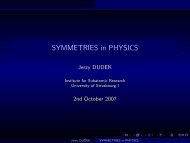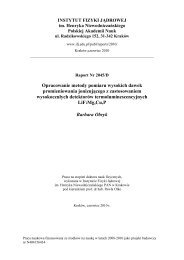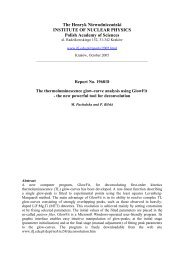Report No 1951/AP - Instytut Fizyki JÄ drowej PAN
Report No 1951/AP - Instytut Fizyki JÄ drowej PAN
Report No 1951/AP - Instytut Fizyki JÄ drowej PAN
Create successful ePaper yourself
Turn your PDF publications into a flip-book with our unique Google optimized e-Paper software.
NON-CARTESIAN SAMPLING IN MRI:<br />
RADIAL AND SPIRAL SEQUENCES<br />
Katarzyna Cieślar, Katarzyna Suchanek, Mateusz Suchanek, Tadeusz Pałasz,<br />
Tomasz Dohnalik, and Zbigniew Olejniczak*<br />
Institute of Physics, Jagellonian University, Kraków, Poland,<br />
*Institute of Nuclear Physics, Kraków, Poland<br />
Data acquisition in the k-space can be accomplished in many different ways. The most<br />
commonly used strategy is the 2DFT (spin-wrap) method (Fig 1 a), where the k-space is<br />
sampled on a regular cartesian grid. The reconstruction of the image is then performed by the<br />
2D FFT algorithm. Among alternative methods of sampling the k-space there are radial and<br />
spiral acquisition schemes. We present two versions of these sequences based on the FID<br />
sampling (Fig 1 b and c). The k-space trajectory is given either by a set of radial lines starting<br />
from the origin of coordinate system, or by a set of interleaved spirals.<br />
The main disadvantage of non-cartesian imaging is a multistep reconstruction process.<br />
The data sets collected along either radial or spiral trajectories need to be regridded onto a<br />
cartesian coordinate system. This process has to account for an uneven distribution of the<br />
sampled data points by applying a proper density compensation weighting. Following this, the<br />
standard 2D FFT is performed to obtain the image.<br />
Due to their inherently high signal-to-noise ratio and short total acquisition time, the<br />
non-cartesian sequences offer great advantages for MRI of living objects, especially in the<br />
case when the motion artifacts have to be eliminated. The first images obtained by these<br />
methods will be presented. Consequently, they will be used in static and dynamic imaging of<br />
rat lungs using polarised helium-3 on our 0.08 T MRI system.<br />
References:<br />
[1]. G.H. Glover, J. M. Pauly, Magn. Reson. Med., 28: 275-289 (1992)<br />
[2]. C. H. Meyer, B. Hu, D. G. Nishimura, A. Mackovski, Magn. Reson. Med., 28: 202-213<br />
(1992)<br />
24

















